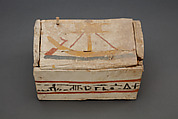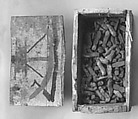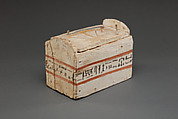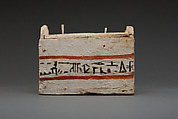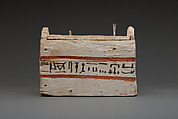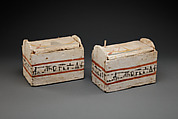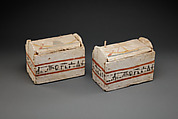Shabti Box of Ankhshepenwepet
Late Period
The burial of Ankhshepenwepet included two small wooden shabti boxes with vaulted ends and flat lids. These were painted white, and inscribed with an offering prayer in black bordered with red lines around the box. As was usual for shabti boxes of this era, each lid was painted with an image of a boat in beige, yellow, and red, with a band of blue-green beneath the boat to represent water. These representations are likely connected with the pilgrimage to the sacred site of Abydos, cult place of the god Osiris, ruler of the dead. By traveling to this holy place, either in reality or symbolically, the deceased became associated with this god and was aided in his or her journey to join the ranks of the blessed dead.
On this box, the boat has its sail up, as if it were traveling south on its return from Abydos to Thebes, with the wind helping move the vessel against the north-flowing current. The other box (25.3.206) depicts a boat with a cabin, probably meant to represent a second vessel towed by the sailing boat; the re-animated deceased could shelter within this kiosk.
Inside the boxes were a total of 374 (158 in one and 216 in the other) small unbaked mud figures called shabtis, one for each day of the year. These were meant to carry out manual labor on behalf of the deceased if she were to be called upon to work in the afterlife.
Due to rights restrictions, this image cannot be enlarged, viewed at full screen, or downloaded.
This artwork is meant to be viewed from right to left. Scroll left to view more.
